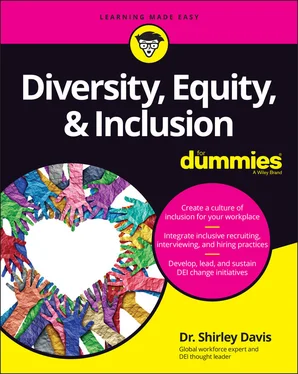Dr. Shirley Davis - Diversity, Equity & Inclusion For Dummies
Здесь есть возможность читать онлайн «Dr. Shirley Davis - Diversity, Equity & Inclusion For Dummies» — ознакомительный отрывок электронной книги совершенно бесплатно, а после прочтения отрывка купить полную версию. В некоторых случаях можно слушать аудио, скачать через торрент в формате fb2 и присутствует краткое содержание. Жанр: unrecognised, на английском языке. Описание произведения, (предисловие) а так же отзывы посетителей доступны на портале библиотеки ЛибКат.
- Название:Diversity, Equity & Inclusion For Dummies
- Автор:
- Жанр:
- Год:неизвестен
- ISBN:нет данных
- Рейтинг книги:3 / 5. Голосов: 1
-
Избранное:Добавить в избранное
- Отзывы:
-
Ваша оценка:
- 60
- 1
- 2
- 3
- 4
- 5
Diversity, Equity & Inclusion For Dummies: краткое содержание, описание и аннотация
Предлагаем к чтению аннотацию, описание, краткое содержание или предисловие (зависит от того, что написал сам автор книги «Diversity, Equity & Inclusion For Dummies»). Если вы не нашли необходимую информацию о книге — напишите в комментариях, мы постараемся отыскать её.
Diversity, Equity & Inclusion For Dummies,
Diversity, Equity & Inclusion For Dummies
Diversity, Equity & Inclusion For Dummies — читать онлайн ознакомительный отрывок
Ниже представлен текст книги, разбитый по страницам. Система сохранения места последней прочитанной страницы, позволяет с удобством читать онлайн бесплатно книгу «Diversity, Equity & Inclusion For Dummies», без необходимости каждый раз заново искать на чём Вы остановились. Поставьте закладку, и сможете в любой момент перейти на страницу, на которой закончили чтение.
Интервал:
Закладка:
 When all employees are valued and invited to participate fully, they’re empowered to bring their best work to the table. Leaders who have an understanding and awareness of the complexities and various elements of diversity, equity, and inclusion are better equipped to recognize and address the gaps that exist within their organizations.
When all employees are valued and invited to participate fully, they’re empowered to bring their best work to the table. Leaders who have an understanding and awareness of the complexities and various elements of diversity, equity, and inclusion are better equipped to recognize and address the gaps that exist within their organizations.
Breaking Down Other Key DEI-Related Terms
In this section, I cover some key terms essential to DEI work. I say “key terms” because I could turn this entire chapter into a glossary, but for the sake of your role as a leader/manager, I just detail the common vocabulary to give you a working knowledge of DEI.
Note: Since 2015, I’ve been selected as one of more than 100 DEI global experts on the revised editions of the Global Diversity, Equity, and Inclusion Benchmarks (GDEIB), and we all weighed in and adopted many of the definitions I share in the following sections. I talk more about the GDEIB in Chapter 6, where I outline how to assess your organization’s current culture.
Ability and disabilities
Equal and fair opportunities should be made to all employees regardless of ability. However, disability diversity isn’t often widely discussed within the DEI conversation. Employers have indicated the anticipated (not actual) costs of adapting the workplace for a differently abled individual as the main barrier to hiring differently abled (disabled) people. Researchers have found that this assumption is really a result of unconscious bias. I discuss unconscious bias later in the chapter, but first I want to give you a clear understanding of the definition of disability.
The World Health Organization (WHO) defines disability as an umbrella term that covers impairments, limitations, and restrictions on participation. It distinguishes an impairment as “a problem in body function or structure,” a limitation as a “difficulty encountered by an individual in executing a task or action,” and participation restriction as “a problem experienced by an individual in involvement in life situations.” Ability refers to one who has the “skills to complete a task, or activity,” so disability can affect how well a person can do any task related to their job.
So the term disability is more complex than simply physical health. Today, WHO estimates that over 1 billion people (15 percent of the world’s population) lives with a disability, and this number continues to rise. Almost everyone will temporarily or permanently experience disability at some point in their life.
 In the United States, the Americans with Disabilities Act (ADA) prevents companies from discriminating against people with disabilities in employment decisions. But hiring is only the first step; businesses also need to create a work environment that makes reasonable accommodations for people with disabilities so they can perform the essential functions of the job.
In the United States, the Americans with Disabilities Act (ADA) prevents companies from discriminating against people with disabilities in employment decisions. But hiring is only the first step; businesses also need to create a work environment that makes reasonable accommodations for people with disabilities so they can perform the essential functions of the job.
All countries who are a part of the United Nations have also adopted laws and acts to protect people with disabilities as their contributions toward the achievement of the Sustainable Development Goals (SDGs) and the pledge of the 2030 Agenda for Sustainable Development to “leave no one behind.”
Belonging
Belonging is a fundamental human need — the desire to feel a sense of security, safety, and acceptance as a member of certain groups. Belonging is what allows employees to feel like they can be their authentic selves without fear of punishment or without having to cover up and be someone they’re not. Workers report that when they feel belonging, they can be more productive.
 If this definition sounds a lot like the ones I introduce for diversity and inclusion earlier in the chapter, keep in mind one of the mantras that DEI professionals use to distinguish the three:
If this definition sounds a lot like the ones I introduce for diversity and inclusion earlier in the chapter, keep in mind one of the mantras that DEI professionals use to distinguish the three:
Diversity is having a seat at the table; inclusion is having a voice; and belonging is having that voice be heard.
BIPOC
The term BIPOC gained a lot of traction and visibility over social media following national protests for social justice and equity in 2020-2021. The term describes any group of people native to a specific region — people who lived in a given region before colonists or settlers arrived. It’s used to acknowledge that not all people of color face equal levels of injustice.
BIPOC stands for Black and Indigenous People of Color and is pronounced “by-poc.” Here’s a breakdown:
Black can refer to dark-skinned peoples of Africa, Oceania, and Australia or their descendants — without regard for the lightness or darkness of skin tone — who were enslaved by white people.
Indigenous refers to ethnic groups native to the Americas who were killed en masse by white people.
People of color is an umbrella term for nonwhite people, especially as they face racism and discrimination in a white-dominant culture.
Implicit bias
Bias is a tendency or inclination that results in judgment without question. Often, biases are unreasoned and based on inaccurate and incomplete information. Everyone has bias. It’s part of the human makeup; you need bias to protect you from danger. Biologically, people are hard-wired to prefer people who look like them, sound like them, and share their interests. But when left unchecked, biases can have a negative impact in every interaction.
Implicit bias (also referred to as unconscious bias ) is an unconscious opinion, positive or negative, that you have about a group or person. Implicit biases are the attitudes or stereotypes that are taught and developed early in life, and they strengthen over time, affecting your understanding, actions, and decisions without your knowing it.
With the vast amount of diversity that makes up the global workforce — including more women, people of color, LGBTQ people, veterans, introverts and extroverts, immigrants, people with different abilities/thinking styles/personalities, and people from five generations, to name a few — the level of complexity and potential conflicts that can arise from unconscious bias is sure to increase. Leaders make decisions in the workplace every day, from sourcing to promotions to creating business strategy and beyond. Whether they recognize it or not, implicit bias enters into every one of these decisions.
 To find out more about implicit bias, as well as other types of biases and how you can deal with them, head to Chapter 15.
To find out more about implicit bias, as well as other types of biases and how you can deal with them, head to Chapter 15.
Intersectionality
Intersectionality refers to complex ways in which people hold many marginal group affiliations at the same time. These identities can combine, overlap, or intersect in a person or group, resulting in multiple, interdependent systems of discrimination or oppression (for example a Black woman, a poor indigenous person, or a gay person with a disability). Thus, the intersectional experience of one person or group is greater than the sum of the individual forms of discrimination or disadvantage.
Читать дальшеИнтервал:
Закладка:
Похожие книги на «Diversity, Equity & Inclusion For Dummies»
Представляем Вашему вниманию похожие книги на «Diversity, Equity & Inclusion For Dummies» списком для выбора. Мы отобрали схожую по названию и смыслу литературу в надежде предоставить читателям больше вариантов отыскать новые, интересные, ещё непрочитанные произведения.
Обсуждение, отзывы о книге «Diversity, Equity & Inclusion For Dummies» и просто собственные мнения читателей. Оставьте ваши комментарии, напишите, что Вы думаете о произведении, его смысле или главных героях. Укажите что конкретно понравилось, а что нет, и почему Вы так считаете.












